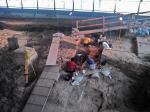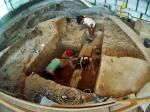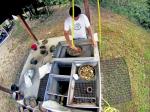Summary (English)
This season’s excavations by Ferrara University at the Palaeolithic site of La Pineta (Isernia) investigated an area (quadrants 156-157-158-159-166-176) in quadrant 1 of sector I. Context 3 was removed (fluvial-lacustrine deposits with sands and fine gravels): from top to bottom, 3s 1-5, 3s 6-9, 3 colluvium, 3s 10 and 3b, in order to reach and expose surface 3c. This surface, excavated over an area of 52 m2 between 1980 and 1993, constitutes the first evidence for human occupation at Isernia La Pineta. It is characterised by the presence of paleontological remains and lithics within a sandy matrix a few centimetres thick, which lay immediately above the travertine layer.
The excavation of these layers produced lithic finds, mainly small flint flakes, and paleontological materials, indeterminate fragments of various sizes but also significant remains of large herbivores, including bison vertebra and horns. These materials were cleaned, consolidated, and restored. Floatation and sieving of the sediment recovered the remains of micro-fauna (mainly rodent teeth and fish vertebra), malacofauna, small fragments of macro-fauna, small flakes of flint and waste elements and sanidine crystals, which are useful for radiometric dating.
The latest results were presented during a workshop at the end of the season. Particular emphasis was given to the discovery of a human tooth found in 2014 in level 3 coll. on the site, which based on the most recent radiometric dating can be attributed to c. 580,000 years ago and at present constitutes the earliest evidence of human presence in Italy. The find, the incisor of a child of 5- 7 years of age, attributed to Homo sp., could probably be attributed to Homo heidelbergensis, who had populated continental Europe in this period.
- Carlo Peretto - Università degli Studi di Ferrara - Dipartimento di Studi Umanistici
- Giuseppe Lembo - Centro Europeo di Ricerche Preistoriche di Isernia
- Brunella Muttillo - Università di Ferrara
Director
- Carlo Peretto – Università degli Studi di Ferrara – Dipartimento di Studi Umanistici
Team
- Dominique Grimaud-Hervé- Museé national d’Histoire naturelle, Paris.
- Giorgio Manzi - "Sapienza" Università di Roma, Dipartimento di Biologia Animale e dell'Uomo
- Jacopo Moggi-Cecchi - Università degli Studi di Firenze - Dipartimento di Biologia
- Julie Arnaud - Università degli Studi di Ferrara
- Alison Pereira - Muséum nationale d’Histoire naturelle/Ferrara/EFR/CEA
- Christophe Falguères – Muséum National d’Histoire Naturelle de Paris
- Jean-Jacques Bahain
- Qingfeng Shao - Isotopic mass spectrometer lab., College of Geography Science, Nanjing Normal University, China
- Sébastien Nomade - CEA Gif-sur-Yvette
- Tristan Garcia - Laboratoire National Henri Becquerel, Gif-sur-Yvette, France
- Maria Diletta Colombo, Soprintendenza Archeologia Molise
- Ursula Thun Hohenstein - Università di Ferrara - Dipartimento di Studi Umanistici
- Alessandro Zanazzi
- Marina Cangemi
- Carmela Vaccaro - Università degli Studi di Ferrara
- Maria Chiara Turrini - Università degli Studi di Ferrara
- Mauro Coltorti - Università degli Studi di Siena
- Marta Arzarello - Università degli Studi di Ferrara
- Rosalia Gallotti
- Vincent Lebreton - Département de Préhistoire du Muséum national d'histoire naturelle
- Benedetto Sala - Università degli Studi di Ferrara
- Claudio Berto – Università di Ferrara
- Marzia Breda- Università degli Studi di Ferrara
- Ronan Orrain
Research Body
- Laboratoire National Henri Becquerel, Gif-sur-Yvette, France
- Laboratoire des Sciences du Climat et de l'Environnement, Gif/Yvette, France
- Muséum national d’Histoire naturelle de Paris
- Nanjing Normal University, Cina
- Sapienza Università di Roma
- Università degli Studi di Ferrara
- Università degli Studi di Firenze
- Università degli Studi di Siena
- Utah Valley University, Stati Uniti d’America
Funding Body
- Muséum national d’Histoire naturelle de Paris
- Università degli Studi di Ferrara






![Download [PDF]](/excavation/skins/fasti/images/results/download_sml.png)

